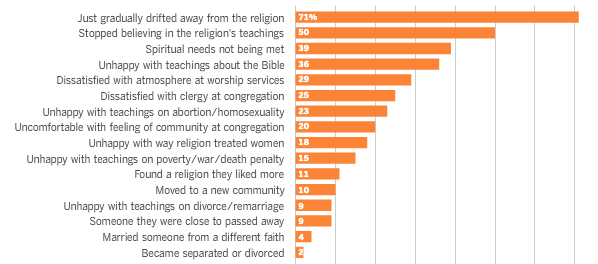The Process of Leaving Church
Sam Rainer

The Pew Forum recently released a follow-up survey to their 2008 US Religious Landscape study. Entitled “Faith in Flux,” this new survey reveals that 28% of American adults have switched from one major religion to another at some point in their lives. The number rises to a 44% switch rate if changes within religious traditions are included, such as from one Protestant denomination to another.
They go further in their report:
The results of the new survey offer a fuller picture of the churn within American religion and suggest that previous estimates actually may have understated the amount of religious change taking place in the U.S. First, among the 56% of the population that currently belongs to the same religion as the one in which they were raised, one-in-six (16%) say there was a time in their life when they had a different faith than they have now. Combined with the 44% of the public that currently espouses a religion different than their childhood faith, this means that roughly half of the U.S. adult population has changed religion at some point in their life.
Their findings also corroborate the high dropout rate of 18-22 year-olds I write about in Essential Church. They report the following about the younger generation:
The survey finds that religious change begins early in life. Most of those who decided to leave their childhood faith say they did so before reaching age 24, and a large majority say they joined their current religion before reaching age 36. Very few report changing religions after reaching age 50.
Additionally, many people who left a religion to become unaffiliated say they did so in part because they think of religious people as hypocritical or judgmental, because religious organizations focus too much on rules or because religious leaders are too focused on power and money. Far fewer say they became unaffiliated because they believe that modern science proves that religion is just superstition.
Steven Koster at ThinkChristian highlighted an important chart from the Pew research:

He says of the chart, “I suppose the biggest thing I see is the gradual drift that seems to factor into the highest categories named. It seems people don’t wake up one day and suddenly say ‘no more church for me!’ It’s a process of alienation, one of quiet struggle I suspect.”
I agree with Koster. The exodus is a process. And the process of leaving begins when the church has no process of discipleship.
One of the biggest problems in churches today is the lack of a clear process of discipleship. One of the signs of a struggling church is the inability to answer the question, “Now what?” A new believer or member becomes part of the body, yet the church does not communicate to them what’s next in order to become more like Christ.
What do you think about the lack of a discipleship process, as well as the process of leaving the church?
You can read the full report here. You can read commentary about the results here, here, and here. Feel free to leave your comments and insight at this blog.






